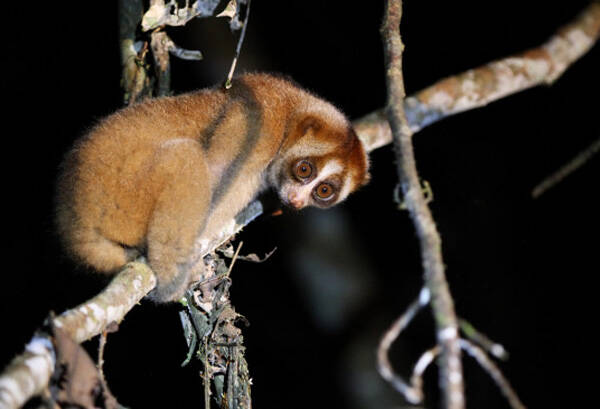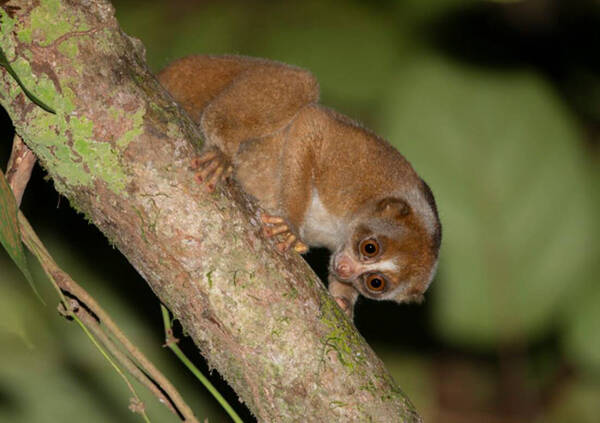Nycticebus menagensis
IUCN
LCBasic Information
Scientific classification
- name:Nycticebus menagensis
- Scientific Name:Nycticebus menagensis,Philippine Slow Loris
- Outline:Primates
- Family:S.loris
Vital signs
- length:About 27.4 cm
- Weight:265-325g, up to 700g
- lifetime:10-25years
Feature
It is the smallest species of loris
Distribution and Habitat
The Philippine slow loris is found in Brunei Darussalam, Indonesia (Kalimantan), Malaysia (Sarawak, Sabah) and the Philippines. It is mainly found in the northern and eastern coastal areas of Borneo (Brunei, Sabah, Sarawak and East Kalimantan) and the southern islands of the Philippines (Tavitawi, Bangor, Sangasanga and some other small islands in the Sulu Archipelago).
The Philippine slow loris can inhabit a variety of habitats. It lives in primary and secondary lowland forests, gardens and plantations at altitudes between 35-100 meters. The species has also been observed in peat swamp forests. They can also live in citrus groves in the Philippines.
Appearance
The Philippine slow loris usually weighs between 265-325 grams, with a maximum weight of 700 grams. With an average body length of 274.2 mm and a skull length of 54.5-56.5 mm, it is the smallest species in the genus Sloris. This species can be distinguished from other slow loris by its light golden to red fur, low contrast markings on the face and head. The second upper incisor is missing, and the ring around the eye is rounded, while the base occasionally extends down below the zygomatic arch. They have a narrow stripe between the eyes, the ears are usually hairless, the patches on the top of the head are mostly scattered, and the width of the fur stripes in front of the ears varies. Compared to the other three species of slow loris in Borneo, the Kalimantan slow loris and the Kayan slow loris are both pale in color, but the body color of this species is pale, and the facial markings are very low contrast, which are significantly lower than the dark facial markings of the Kayan slow l
Details
Philippine Slow Loris (Nycticebus menagensis) is a primate of the order Prosimian, a slow loris native to the northern and eastern coastal areas of Borneo Island and the Sulu Islands of the Philippines. The animal was first named Bornean slow loris in 1892, but was included in the widely distributed interslow loris (N. coucang) in 1952. However, based on molecular analysis in 2006, it was promoted to full species status - again considered to be the Bornean slow loris. In 2013, the species complex collectively known as the Bornean slow loris (Nycticebus menagensis) was divided into four species: the Philippine slow loris (Nycticebus menagensis), the Kalimantan slow loris (Nycticebus borneanus), the Bangka Island slow loris (Nycticebus bancanus) and the Kayan River slow loris (Nycticebus kayan).

The Philippine Slow Slow is a nocturnal animal that is almost arboreal. Found in Sabah, the Philippine Slow Slow often sleeps in dense trees characterized by lianas and climbers, choosing multiple trees to sleep in, reusing each tree only a few times. 50% of the Philippine slow lorises found in Sabangao National Park consist of two or more individuals living together and foraging in the same tree.
Data from the Philippine slow lorises in Sabah and Sarawak indicate that the social organization of the species consists of one male with multiple female offspring. The family territory ranges about 9 hectares. The diet of the species mainly consists of sap, insects and small vertebrates. Fruits are also eaten, but rarely.
The gestation period of the Philippine slow lorises is about 190 days, and females usually give birth to one baby per litter. The baby initially clings to the mother, but later stays on the branch while the mother searches for food. The mother licks the baby and protects it with her own venom. The baby is weaned after about 5-7 months and becomes sexually mature after one and a half to two years. In captivity, these animals can live for more than 25 years.

Habitat burning and conversion, especially to palm oil plantations, pose a threat to the Philippine slow loris. Although it is relatively adapted to anthropogenic habitats and therefore may be less affected by forest loss than other primate species, forest loss in the region is severe enough that it may have some negative impacts. The species is acquired locally for use as pets; the subsequent uncontrolled release of pets in some areas is also a threat. Captured wild animals are also used as tourist attractions in some hotels or tourist camps in Borneo. The forest fires in Borneo in 2015 were the worst since 2004, with large tracts of forest burned, resulting in a significant reduction in the species' habitat. Lack of law enforcement further threatens the distribution of the species throughout its range.
The Philippine slow loris is included in Appendix I of CITES and is protected under the laws of Indonesia, Malaysia, Brunei, and the Philippines. In Indonesia, it is protected by the Decree No. 5 of the Republic of Indonesia on the Conservation of Biological Resources and Their Ecosystems of 1990, which prohibits the capture, harming, killing, storing, possessing, cultivating, transporting, and trading in protected live animals. It can only be used for the purpose of research, science, rescuing animals, or in cases where the animals endanger human life. In Brunei, the Wildlife Conservation Act (1981) states that the slow loris is a protected species and cannot be hunted without a license. In wildlife sanctuaries, it is completely prohibited to shoot, hunt, kill, capture or take any animal. In Sabah, Malaysia, the Wildlife Conservation Act (2010) No. 716 has clearly stated that the species is a completely protected species. Special permits are required for zoos, commercial captive breeding, circuses, wildlife exhibitions, research and hunting of slow loris. Trading in individuals or parts of individuals also requires special permits. In the Philippines, it is protected by the Wildlife Resources Conservation and Protection Act (2001). Only certified individuals can own slow loris for scientific, conservation or breeding purposes. Commercial breeding is allowed if the minimum requirements are met. Killing wildlife is prohibited unless for rituals of indigenous communities. Trading in wildlife is prohibited. Collecting, hunting or possessing wildlife and their derivatives is prohibited.
Listed in the IUCN Red List of Threatened Species in 2015 ver 3.1 - Vulnerable (VU).
Listed in the CITES Appendix I of the Washington Convention as a protected animal.
Protect wild animals and eliminate game.
Maintaining ecological balance is everyone's responsibility!








